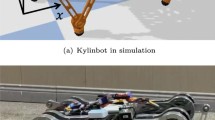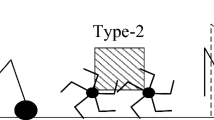Abstract
Humans can walk efficiently in a certain speed range, while state-of-the-art biped robots can hardly walk as fast as humans. In this paper, we investigate how to walk faster for two simple 2D walking models (Zaytsev in IEEE Trans Robot 34:336–352, 2018), including an inverted pendulum (IP) model and a linear inverted pendulum (LIP) model. Firstly, open-loop analysis is conducted based on the two models. The concept of “acceleration factor” is proposed, which is a key parameter that affects the mid-stance velocity transition between steps. We find that the acceleration factor has a fixed correlation with the velocity transition trend, which is independent of the step length. The step length only affects the feasible range of the acceleration factor, which suggests that we can decouple the control of walking speed from step length. Based on this, we design walking controllers for both models, where the walking velocity and step length are controlled separately. With the proposed controller, closed-loop simulations are performed in the V-REP software, which achieves a mid-stance velocity of 2 and 6 m/s for IP walking and LIP walking, respectively. Besides, walking with varied step lengths along with speed regulation is also demonstrated. This work might be helpful to improve the walking speed of biped robots in the future.


























Similar content being viewed by others
Data availability
The authors declare that the data supporting the findings of this study are available within the article and the video attachment.
References
Zaytsev, P., Wolfslag, W., Ruina, A.: The boundaries of walking stability: Viability and controllability of simple models. IEEE Trans. Robot. 34(2), 336–352 (2018)
Srinivasan, M., Ruina, A.: Computer optimization of a minimal biped model discovers walking and running. Nature 439(7072), 72–75 (2006)
McGeer, T.: Passive dynamic walking. Int. J. Robot. Res. 9, 62–82 (1990)
Collins, S., Ruina, A., Tedrake, R., Wisse, M.: Efficient bipedal robots based on passive-dynamic walkers. Science 307, 1082–1085 (2005)
Bhounsule, P.A., Cortell, J., Grewal, A., Hendriksen, B., Karssen, J.D., Paul, C., Ruina, A.: Low-bandwidth reflex-based control for lower power walking: 65 km on a single battery charge. Int. J. Robot. Res 33, 1305–1321 (2014)
Hobbelen, D.G., Wisse, M.: Controlling the walking speed in limit cycle walking. Int. J. Robot. Res. 27(9), 989–1005 (2008)
Ye L. and Chen X..: Understand human walking through a 2D inverted pendulum model. in IEEE-RAS International Conference on Humanoid Robots (Humanoids), pp. 340–345, 2018.
Norberg, J.D.: Biomechanical analysis of race walking compared to normal walking and running gait. University of Kentucky, Lexington, Kentucky (2015)
Lau C.: Speed of the fastest human walking. in The physics factbook: An encyclopedia of scientific essays, online.
Kajita, S., Hirukawa, H., Harada, K., Yokoi, K.: Introduction to humanoid robotics. Springer, Heidelberg, Berlin (2014)
“Asimo Frequently Asked Questions,” online, available at https://asimo.honda.com/downloads/pdf/honda-asimo-robot-fact-sheet.pdf
Van der Noot, N., Ijspeert, A.J., Ronsse, R.: Bio-inspired controller achieving forward speed modulation with a 3D bipedal walker. Int. J. Robot. Res. 37(1), 168–196 (2018)
Sreenath, K., Park, H.W., Poulakakis, I., Grizzle, J.W.: A compliant hybrid zero dynamics controller for stable, efficient and fast bipedal walking on MABEL. Int. J. Robot. Res. 30(9), 1170–1193 (2011)
Rezazadeh, S., Hurst, J.W.: Control of ATRIAS in three dimensions: walking as a forced-oscillation problem. Int. J. Robot. Res. (2020). https://doi.org/10.1177/0278364920916777
Seok, S., Wang, A., Chuah, M.Y., Hyun, D.J., Lee, J., et al.: Design principles for energy-efficient legged locomotion and implementation on the MIT cheetah robot. IEEE/ASME Trans. Mechatron. 20(3), 1117–1129 (2014)
Rohmer E., Singh S. P., and Freese M.: V-REP: A versatile and scalable robot simulation framework. in IEEE/RSJ International Conference on Intelligent Robots and Systems (IROS), pp. 1321–1326, 2013.
Raibert, M.H.: Symmetry in running. Science 231(4743), 1292–1294 (1986)
Wisse M., Atkeson C. G., and Kloimwieder D. K.: Swing leg retraction helps biped walking stability. in IEEE-RAS International Conference on Humanoid Robots (Humanoids), pp. 295–300, 2005.
Funding
This work was supported by the National Natural Science Foundation of China under Grant No. 62003188 and Grant No. 92248304, The Shenzhen Science Fund for Distinguished Young Scholars (RCJC20210706091946001).
Author information
Authors and Affiliations
Corresponding authors
Ethics declarations
Conflict of interest
The authors declare that they have no conflict of interest.
Additional information
Publisher's Note
Springer Nature remains neutral with regard to jurisdictional claims in published maps and institutional affiliations.
Rights and permissions
Springer Nature or its licensor (e.g. a society or other partner) holds exclusive rights to this article under a publishing agreement with the author(s) or other rightsholder(s); author self-archiving of the accepted manuscript version of this article is solely governed by the terms of such publishing agreement and applicable law.
About this article
Cite this article
Ye, L., Wang, X., Liu, H. et al. Bipedal walking control by using acceleration factor. Nonlinear Dyn 111, 16049–16062 (2023). https://doi.org/10.1007/s11071-023-08708-z
Received:
Accepted:
Published:
Issue Date:
DOI: https://doi.org/10.1007/s11071-023-08708-z




